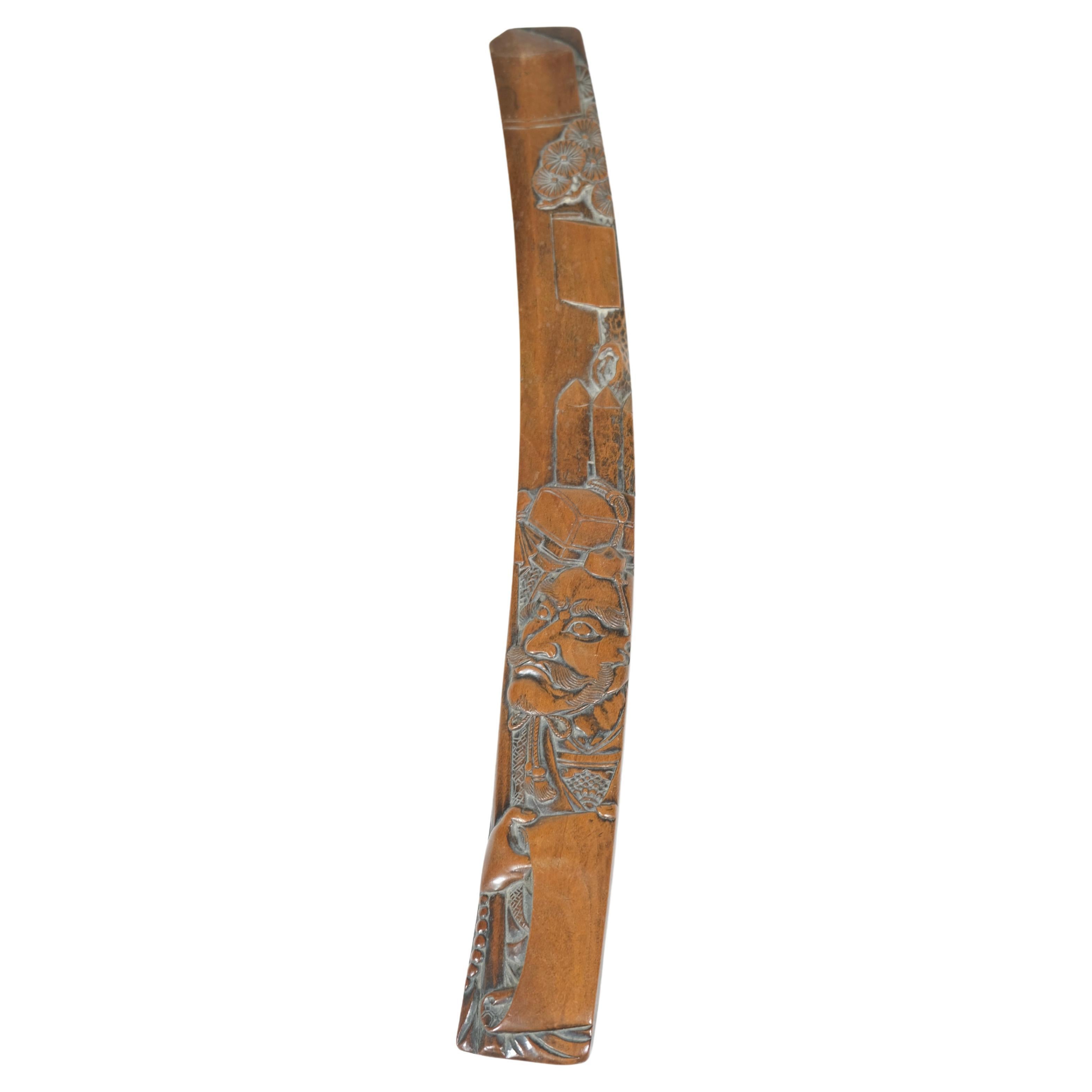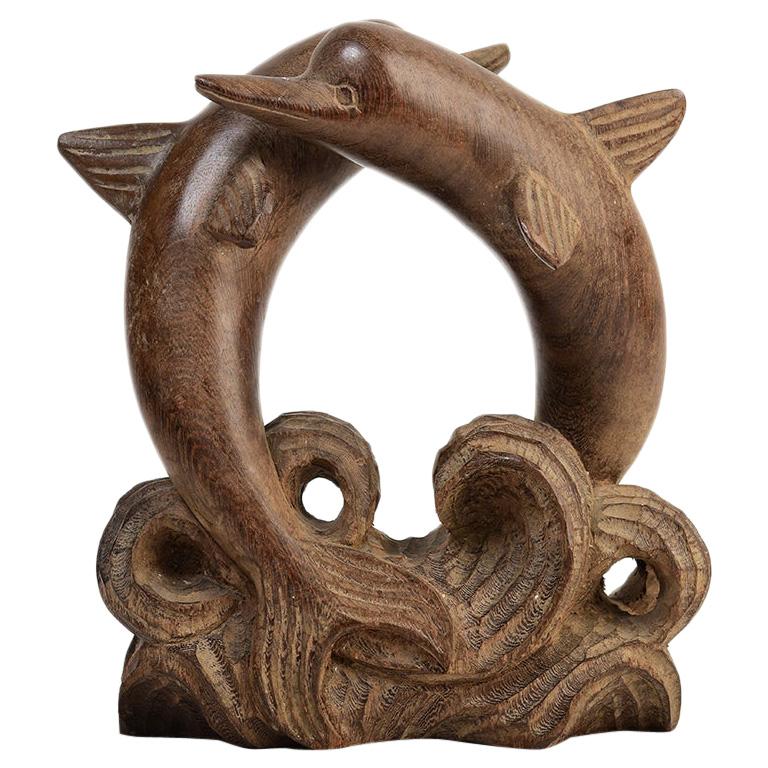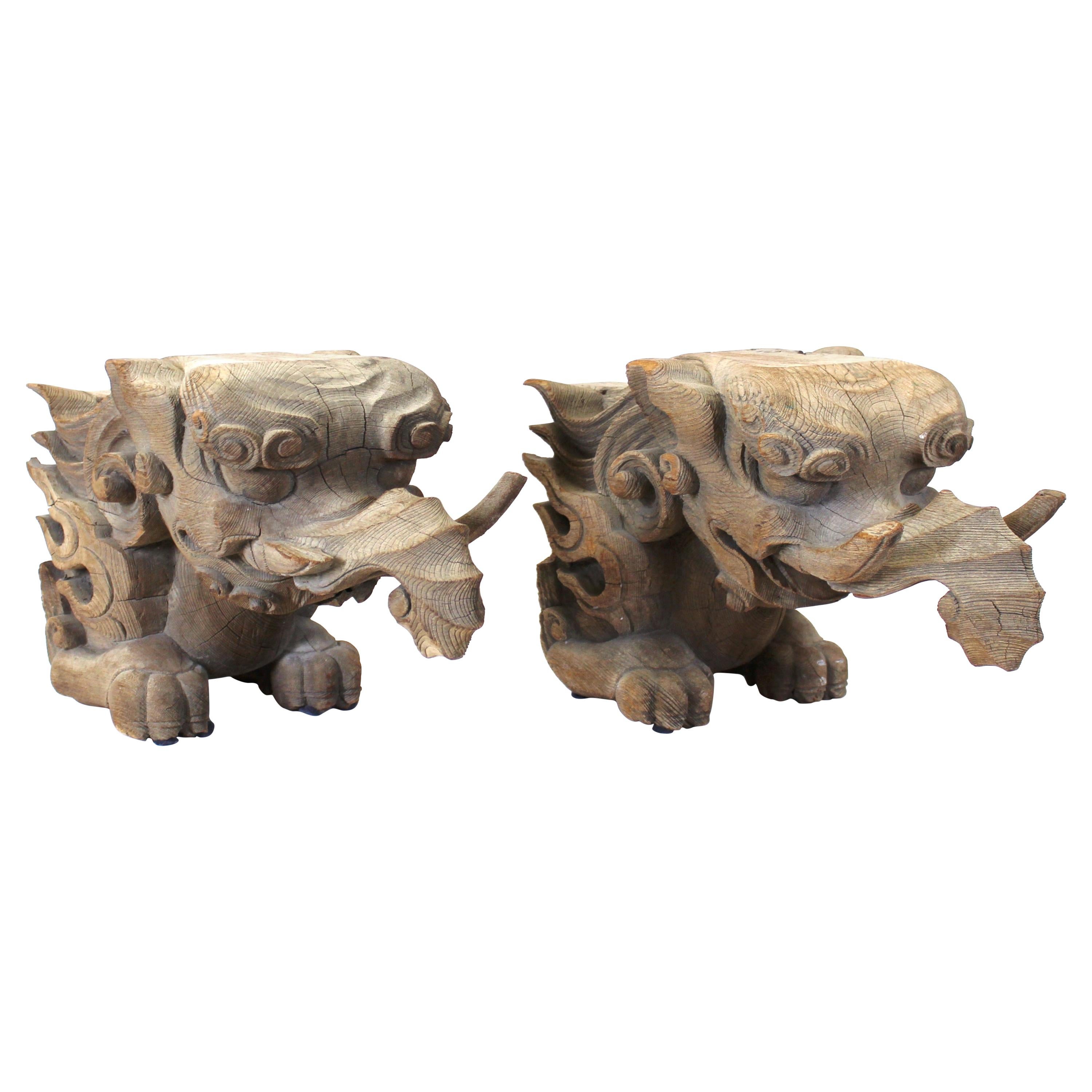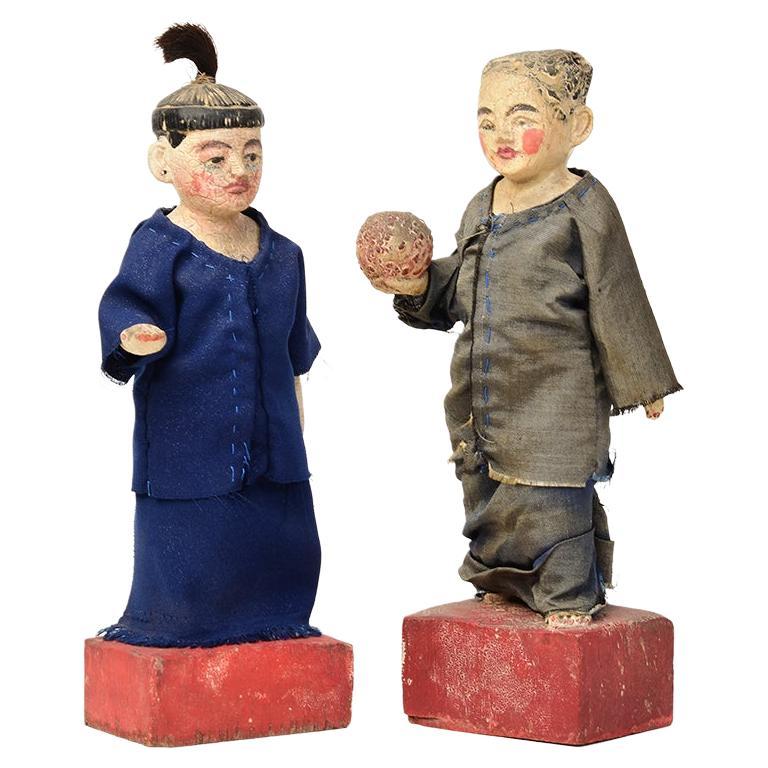Items Similar to Pair of Japanese Carved Wooden Temple Ornaments 木鼻 'Kibana' Shaped like Baku 獏
Want more images or videos?
Request additional images or videos from the seller
1 of 16
Pair of Japanese Carved Wooden Temple Ornaments 木鼻 'Kibana' Shaped like Baku 獏
About the Item
A lovely pair of very detailed carved wooden temple ornaments (kibana) in the shape of elephant-like mythical creatures known as ‘Baku’.
Baku are Japanese supernatural beings that are said to devour nightmares. These creatures have the trunk and tusks of an elephant, the eyes of a rhinoceros, the tail of a cow, and the paws of a tiger.
Kibana are ornaments placed at the top of pillars or at the corners of beams in a temple so they could serve as guardians of the temple. The last photo is an example of how similar kibana originate.
One baku has its mouth open while the other’s is shut. As a part of Buddhist symbolism the open mouth is meant to be forming the sound “a”, while the closed mouth is forming the sound “un”. Combined, they form the word a-un. “a” and “un” are symbolic of all beginnings and endings.
Legend has it that a person who wakes up from a bad dream can call out to baku. A child having a nightmare in Japan will wake up and repeat three times, "Baku-san, come eat my dream." Legends say that the baku will come into the child's room and devour the bad dream, allowing the child to go back to sleep peacefully. However, calling to the baku must be done sparingly, because if he remains hungry after eating one's nightmare, he may also devour their hopes and desires as well, leaving them to live an empty life. The baku can also be summoned for protection from bad dreams prior to falling asleep at night.
When shipped we will add a certificate of authenticity.
Price including insured shipping.
- Dimensions:Height: 12.6 in (32 cm)Width: 8.08 in (20.5 cm)Depth: 19.3 in (49 cm)
- Sold As:Set of 2
- Materials and Techniques:
- Place of Origin:
- Period:
- Date of Manufacture:1600-1868
- Condition:Wear consistent with age and use. In a very nice original condition with wear consistent with age. Please look at the photos for a condition reference.
- Seller Location:Amsterdam, NL
- Reference Number:
About the Seller
5.0
Vetted Seller
These experienced sellers undergo a comprehensive evaluation by our team of in-house experts.
Established in 1996
1stDibs seller since 2022
16 sales on 1stDibs
Typical response time: 13 hours
- ShippingRetrieving quote...Ships From: Amsterdam, Netherlands
- Return PolicyA return for this item may be initiated within 14 days of delivery.
More From This SellerView All
- Large pair of Japanese ‘Jyôka’ 常花, sets of gilded lotus flowers and -leaves.Located in Amsterdam, NLA spectacular pair of black glass vases each adorned with 13 large handmade gilded wooden lotus flowers and -leaves with refined details. Such a set is known as ‘Jyôka’, and are typically positioned on or beside an altar in a Buddhist temple. The lotus flowers are at different stages of their life (unfurled lotus leaves, buds and blooms) and symbolize the journey towards Buddhist enlightenment. What sets this pair apart is its size; it is considerably larger than many similar sets, making it a rare find. As well as that it has such an extensive array of gilded flowers. The flowers, which are detachable, allow for customizable arrangements within the vases. Period: Japan – lotuses...Category
Antique Late 19th Century Japanese Antiquities
MaterialsGlass, Giltwood, Lacquer
- Pair of Japanese High Quality Chôshi 銚子 'Sake Ewers', Signed 'Sei’ô' 晴王Located in Amsterdam, NLPair of high quality cast iron chôshi (sake ewers) with a detailed lacquered lid. Its body with a refined embossed design of a bird of prey (môchô) perched o...Category
Antique Late 19th Century Japanese Antiquities
MaterialsIron
- Pair of Japanese Red Lacquered Hibachi 火鉢 'Fire Bowls' Shaped like FlowersLocated in Amsterdam, NLPair of magnificent hibachi (fire bowls) shaped like chrysanthemum flowers (kiku) and finished with high quality ‘bordeaux red’ lacquer. Each is carved from a solid piece of wood with fine elegant lobes representing the petals. The interior fitted with a copper lining, for the coals, with a nice patina. A pair of hibachi in this colour and with this kind of quality of Material is rare to find! In Japan chrysanthemums are believed to represent happiness, longevity, rejuvenation and nobility. Including original wooden tomobako (storage box). In Western culture these bowls are often used as decorative flower pots...Category
20th Century Japanese Lacquer
MaterialsCopper
- Japanese Edo-period gosho’ningyô 御所人形 (palace doll) of plump, seated childLocated in Amsterdam, NLA charming gosho’ningyô (palace doll) of plump, seated child with a brilliant white skin and a small delicately elegant face, reminiscent of a young noble. The doll is playfully rais...Category
Antique Early 19th Century Japanese Antiquities
MaterialsPaste, Silk, Paint
- Red lacquer Festival Flag Support abundantly inlaid with mother-of-pearl, JapanLocated in Amsterdam, NLRare museum-worthy Japanese lacquered wooden festival support for a flag. In feudal Japan this kind of supports sat on the back of a horse or ox during pr...Category
Antique 19th Century Japanese Antiquities
MaterialsMetal, Bronze, Copper
- Signed Japanese Edo suji’bachi kabuto (helmet) with a moon & cloud maedateLocated in Amsterdam, NLAn antique, outstanding signed suji’bachi kabuto (helmet with ridges) surmounted by a gilt metal maedate (forecrest) shaped like a full moon emerging from the clouds heightened by a ...Category
Antique Early 19th Century Japanese Antiquities
MaterialsMetal, Iron
You May Also Like
- Japanese Wooden Dagger, Late 19th CLocated in Stockholm, SEA Japanese high quality wooden dagger. The carving is made of the highest quality as often Japanese items are. There is a signature and a poem engraved on side. Comes from an old Swedish collection...Category
Antique Late 19th Century Japanese Edo Sculptures and Carvings
MaterialsBoxwood
- 20th Century, A Pair of Burmese Wooden DolphinsLocated in Sampantawong, THA pair of Burmese wooden dolphins. Age: Burma, 20th century Size: Height 21.5 C.M., Width 9 C.M., Length 17.3 C.M. Condition: Nice condition overall. ...Category
20th Century Burmese Antiquities
MaterialsWood
- 19th C., Mandalay, A Pair of Antique Burmese Wooden Seated Monks / DisciplesLocated in Sampantawong, THA pair of Burmese wooden seated disciples. Age: Burma, Mandalay period, 19th century Size: Height 26 - 27.5 C.M. / Width 24.7 - 25.4 C.M. Condition: nice condition overall (some exp...Category
Antique 19th Century Burmese Antiquities
MaterialsWood
- Japanese Momoyama Baku Figures in Carved Keyaki WoodLocated in New York, NYJapanese Momoyama period rare early pair of Baku figures, carved in keyaki wood with an exquisite wood grain, 17th century, circa 1650. The elephant-like Baku is an imaginary and co...Category
Antique 17th Century Japanese Sculptures and Carvings
MaterialsWood
- Japanese Momoyama Carved Wooden Shinto Temple Lion Dog FiguresLocated in New York, NYJapanese Momoyama period carved wooden Shinto temple entry figures in the form of royal lion dogs seated in traditional pose. The pieces have had some co...Category
Antique 17th Century Japanese Edo Sculptures and Carvings
MaterialsWood
- Early 20th Century, a Pair of Burmese Wooden Male and Female FigurinesLocated in Sampantawong, THA pair of Burmese wooden male and female figurines. Age: Burma, early 20th century Size: Height 31 - 32.4 C.M. / Width 10.1 - 10.4 C.M. Condition: Nice condition overall (some expec...Category
Early 20th Century Burmese Antiquities
MaterialsWood
Recently Viewed
View AllMore Ways To Browse
Like Antique
Antique Like Furniture
Wooden Last
Antique Wood Ornaments
Pair Temple
Antique Dreams
Wooden Ornaments
Carved Pillar
Antique Beams
Carved Wood 19th Century Japanese
Wooden Sculpture Japanese
Japanese Temple Sculpture
Temple Japanese Buddhist
Japanese Wood Temple
Japanese Buddhist Sculpture
Shut The
Japanese Wooden Carved
Wooden Beam





